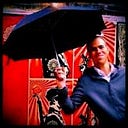Reverse innovation is a concept I first discovered through @danmcquillan and his brilliant article on digital reverse development which is “what you get if you combine new technology with methodologies of participatory development, as in CDI’s Apps for Good. What leaks back to the West is innovation from cultures that haven’t lost the idea of community and collective action as much as we have. Innovation from elsewhere allows us to see ourselves differently.”
Anyway, recent events have got me thinking that as well as looking for answers within the very actors of those events, looking elsewhere could help too.
About a decade ago, I went with other young people on an exchange to South Africa to immerse ourselves in new techniques and environments for youth activism. Below are the experiences I documented, I’ve picked out some thoughts I had back then, I wonder how helpful there are now?
From shark cages to talking walls: “They enable people to look at memory practices to share experiences and creatively explore the many ways memory work…Could this work for “community cohesion” projects in areas where there has been a past of cultural or ethnic tension?
From rape crisis survivors developing their skills in user-led organisations: “They facilitate one-to-one sessions with the survivor and do work with their families separately to protect their confidentiality. However, if the survivor is keen to have a joint session, that can be arranged.”
From flashmobs, texting to the condom king: “What I found most inspiring is how they get people on the streets involved in mass demonstrations. To do this, members go into their communities to organise…getting people from different backgrounds to be able to share stories, laughs and good food together without feeling the chains of inequality and inferiority”.
From condacons to spazashops: “Seeing someone being able to attract crowds of 20–30 people in the space of half an hour just by mingling at a market stall”.
From tortoises to the dance of equals: “How can we mobilise gang leaders — who are trusted by their peers and reference points in the community — to turn on the social change? At the end of the day, it’s about creating the spaces to listen and let people open up and explore their insecurities which may be crystallised through prejudice, such as racism, sexism or ageism.”
From tax avoidance to human rights: “We then had a discussion about we could make a difference here, something where we do need to increase attention is around tax dodging by multinationals and unfair contracts”.
From buffet bellies to corporate social responsibility: “We went there to paint their new dormitories, but arriving with our buffet bellies and branded tshirts, we wondered if it didn’t cost more to bring us here as part of a corporate volunteering initiative.”
From Soweto to the university: “Albeit being a senior civil servant, he was dressed in a tshirt and blazer, which really relaxed the atmosphere. He was bombarded with questions about the “skills race” and was true to form.”
From supporting entrepreneurs to working yourself out of a job: “Given the important role women have in the informal economy, when they join government welfare-to-work programmes, when the programme finishes, they are displaced from that informal economy. This brought home to me the question of how can people or groups organise in the informal economy?”
From grafitti murals to the capuccino effect: “Access to education is still based on apartheid not through law but through income. They were very concerned that if the ANC keep going along on the gravy train, they will eventually fall”.
